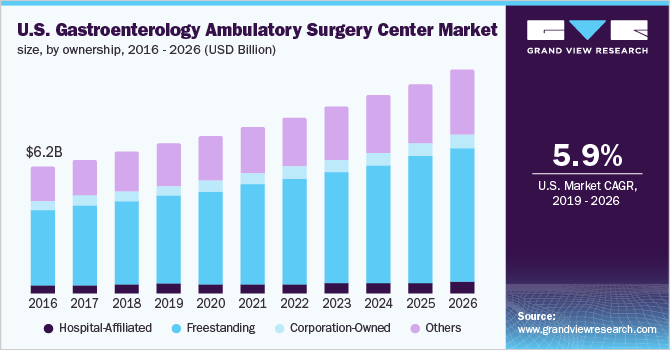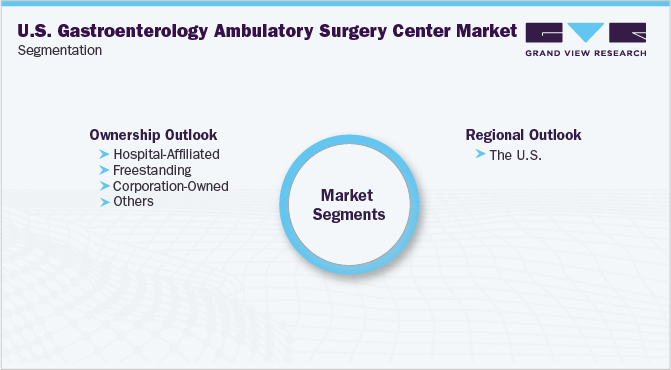
U.S. Gastroenterology Ambulatory Surgery Center Market Size, Share & Trends Analysis Report By Ownership (Hospital-affiliated, Freestanding, Corporation-owned), And Segment Forecasts, 2019 - 2026
- Report ID: GVR-3-68038-928-9
- Number of Pages: 111
- Format: Electronic (PDF)
- Historical Range: 2015 - 2017
- Industry:Healthcare
Report Overview
The U.S. gastroenterology ambulatory surgery center market size to be valued at USD 10.8 billion by 2026 and is expected to grow at a compound annual growth rate (CAGR) of 5.91% during the forecast period. Growing incidences of gastrointestinal disorders, rising geriatric population, overcrowding of the Hospital Outpatient Department (HOPD), and rising preference for ambulatory services to avoid unnecessary hospitalization charges are the major factors driving the market growth. According to the American Hospital Association's (AHA) 2019 Hospital Statistics report, in 2017, the outpatient revenue increased significantly and was around 95% of the inpatient revenue. This was mainly due to reduced inpatient admissions as compared to outpatient visits. The overall outpatient visits increased by 1.2% year-on-year while the hospital admission increased by less than 1%. This slowdown in hospital admissions shows the rising preference of the patients towardAmbulatory Surgery Centers(ASCs).

Rising healthcare costs are a major concern disrupting the industry and with it comes the fact that not all patients are capable to afford the cost of treatment that they need. This issue has forced healthcare service providers to find out an alternative to provide high-quality treatment at an affordable price. ASCs have proven to be an effective solution in this scenario. In the U.S., visits to ASCs for the treatment of gastrointestinal diseases are steadily increasing. Gastroenterology is one of the most common surgical specialties in multi- and single-specialty ASCs.
Medicare is the largest payer for ambulatory services in the country. From January 2017, Centers for Medicare and Medicaid Services (CMS) increased the reimbursement rate for endomicroscopy in upper GI endoscopy procedures in hospitals and in ambulatory surgical centers. Since ASCs include low admin cost but no hospitalization cost, ASC remains a more profitable business for the physicians when compared to hospitals. According to the Definitive Healthcare data, in 2017, ASCs performed more than 7.7 million Medicare procedures.
U.S. Gastroenterology Ambulatory Surgery Center Market Trends
The market size is increasing due to factors such as an increase in chronic diseases, an increase in the elderly population, unhealthy lifestyles, and an increase in the number of surgeries in the U.S. all of these factors drive the market in the forecast period.
As there is rise in the number of surgical procedures mainly for inpatient surgeries, mainly for minor procedures such as minor joint repair, abdominal hernia repair, gall bladder removal, cataract surgery, and other procedures thereby resulting in rise in the patient load in hospitals. The growing influx of patients is one of the biggest drivers to the market growth.
医疗价格的上涨作为限制the growth of the market. Besides, the lack of access to medical services and the treatment limits the market growth. The market size is going to increase in the future because of the increased prevalence of technologically advanced surgical procedures such as minimally invasive surgeries and the increased acceptance and growing awareness among the patients about these procedures being offered at ambulatory centers. This acts as a huge opportunity for growth in the future for the growth of the market in the forecast period.
Ownership Insights
On the basis of ownership, the U.S. gastroenterology ambulatory surgery center market has been segmented into hospital-affiliated, freestanding/physician-owned, corporation-owned, and others. The other segment includes ventures between physician-hospital, physician-corporation, and physician-corporation-hospital. The freestanding segment (mainly comprising physician-owned ambulatory surgery centers) accounted for the highest market share in 2018, owing to maximum professional control over the clinical environment and quality of care delivered to patients. It allows physicians to focus on a small number of procedures in a single setting. With hands-on control, physicians maintain quality control processes in ASCs within a smaller space and fewer operating rooms as compared to hospitals.
The rising burden of surgical procedures in the hospital increases the demand for ASC to perform various procedures such as urology, gastrointestinal, and ophthalmic surgery. Endoscopic Ambulatory Surgery Centers (EASC) are the freestanding facilities designated to carry out gastrointestinal procedures at a low cost. These facilities are more competent than the hospital and offer an added source of revenue to the healthcare providers. According to Becker’s review of GI and Endoscopy in ASCs, in the U.S., around 25% of all cases in ASCs involve GI/endoscopic procedures. Also, more than 27% of all the single-specialty surgery centers are driven due to gastroenterology procedure
Regional Insights
高采用先进的手术过程ures such as minimally invasive surgeries and new endoscopy technologies are the key factors driving the ambulatory surgery centers market in U.S. In addition, the high cost of medical services offered by physicians in the country and unnecessary hospitalization, create the need for cost-effective and efficient treatment options for patients seeking treatment. According to the data published by The National Institute of Diabetes and Digestive and Kidney Diseases (NIDDK), 60 to 70 million people suffer from gastrointestinal diseases each year in U.S. The most common diseases includeGastroesophageal Reflux Disease (GERD), Irritable Bowel Syndrome (IBS), indigestion, constipation, diarrhea, and abdominal pain.
Key Companies & Market Share Insights
The U.S. gastroenterology ASC market space has been divided based on manufacturers and service providers. Key manufacturers operating in the market are Cardinal Health, Medtronic PLC, Ethicon (Johnson & Johnson), Boston Scientific, Olympus, Becton Dickinson (BD), Hill-Rom Holdings, GE Healthcare, Koninklijke Philips N.V., and Cook Medical.
Companies such as Medtronic, Olympus, Becton Dickinson, and Johnson & Johnson have a wide product portfolio for gastroenterology procedures. Technological advancements in the field of endoscopy is a major factor driving the market. For instance, in March 2019, Olympus Corporation announced the development of its new AI-based CAD Open Platform to assist in the detection and diagnosis of diseases during endoscopic examinations.
Key participants in the service segment include Envision Healthcare Corporation, Tenet Healthcare Corporation; Surgery Partners; Community Health Systems, Inc. (CHS); Universal Health Service (UHS); Hospital Corporation of America (HCA); Surgery Care Affiliates (SCA); SurgCenter Development; Covenant Surgical Partners; and Regent Surgical Health.
Strategic partnerships and acquisitions for facility expansion are the major growth strategies being implemented by the key service providers. For instance, in January 2017, Surgical Care Affiliates, Inc. (SCA) underwent an agreement with Optum to expand the services of OptumCare’s outpatient surgical procedures.
U.S. Gastroenterology Ambulatory Surgery Center Market Report Scope
Report Attribute |
Details |
Revenue forecast in 2026 |
USD 10.8 billion |
Growth rate |
CAGR of 5.91% from 2019 to 2026 |
Base year for estimation |
2018 |
Historical data |
2015 - 2017 |
Forecast period |
2019 - 2026 |
Quantitative units |
Revenue in USD million/billion and CAGR from 2019 to 2026 |
Report coverage |
Revenue forecast, company share, competitive landscape, growth factors and trends |
Segments covered |
Ownership |
Country scope |
U.S. |
Key companies profiled |
Cardinal Health; Medtronic PLC; Ethicon (Johnson & Johnson); Boston Scientific; Olympus; Becton Dickinson (BD); Hill-Rom Holdings; GE Healthcare; Koninklijke Philips N.V.; Cook Medical |
Customization scope |
Free report customization (equivalent up to 8 analysts working days) with purchase. Addition or alteration to country, regional & segment scope. |
革命制度党cing and purchase options |
Avail customized purchase options to meet your exact research needs.Explore purchase options |
U.S. Gastroenterology Ambulatory Surgery Center Market Segmentation
This report forecasts revenue growth at the country level and provides an analysis of the latest industry trends in each of the sub-segments from 2015 to 2026. For this study, Grand View Research has segmented the U.S. gastroenterology ambulatory surgery center market based on ownership:

Ownership Outlook (USD Million, 2015 - 2026)
Hospital-Affiliated
Freestanding
Corporation-Owned
Others
Regional Outlook (USD Million,2015 - 2026)
U.S.





